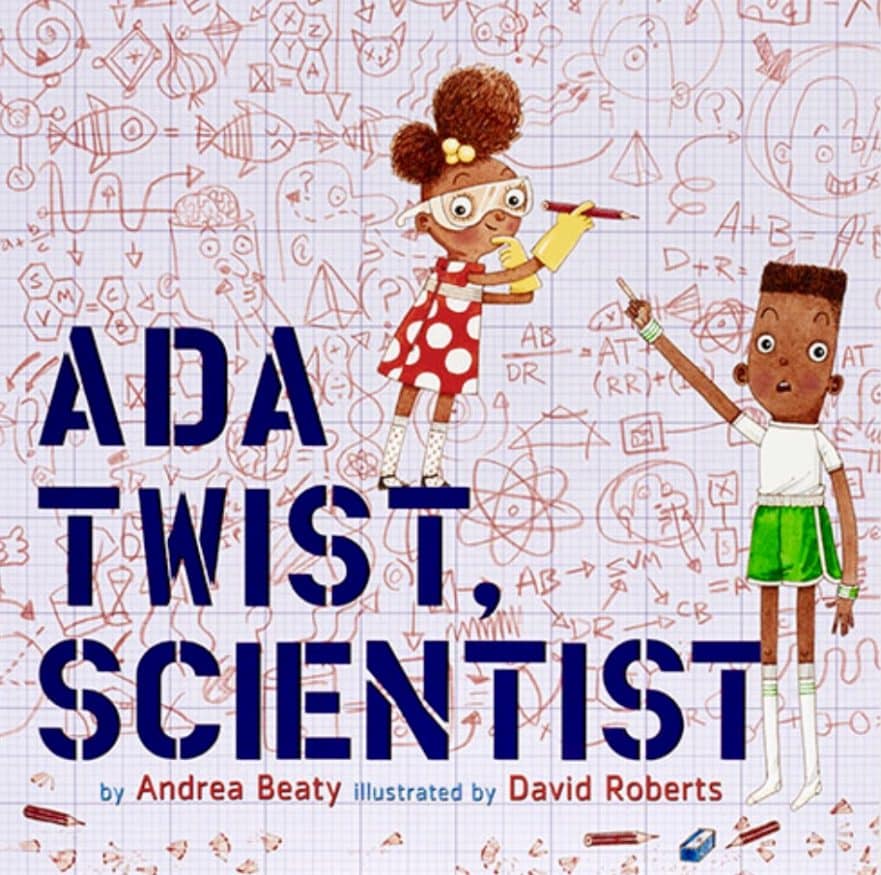Hands up if you ever had a question that no one could answer. Did you ever find an answer? Scientists spend their lives trying to answer questions………… Children are born eager to learn. Curious by nature, we can’t keep them from exploring as they try to comprehend their environment. Everything is a wonder. When conditions allow children to satisfy curiosity through safe, self-initiated, and playful exploration, learning occurs naturally.
******************************
A brilliant and beautiful rhyming book about supporting children’s curiosity.
ADA TWIST, SCIENTIST

Andrea Beaty – Author
David Roberts – Illustrator
Ada Marie has a boundless imagination and has always been hopelessly curious. Saying nothing until the age of three, she suddenly starts asking her parents, ‘Why?’ ‘What?’ ‘How?’ and ‘When?’ at every available opportunity. Why are there pointy things stuck to a rose? Why are there hairs growing inside your nose?

As Ada grows up, her curiosity wreaks havoc at school, but she has all the traits of a great scientist. When her house fills with a horrific, toe-curling smell, Ada knows it’s up to her to find the source. What would you do with a problem like this? Not afraid of failure, Ada embarks on a fact-finding mission and conducts scientific experiments, all in the name of discovery. But, this time, her experiments lead to even more stink and get her into a bit of trouble .

*************************************
*************************************

Special thanks to THE HUNTINGTON – Library, Art Museum and Botanical Gardens for today’s activities.
*************************************
ACTIVITY 1 – SMELL-A-THING-THING
Ada is an inventive scientist who never stops asking questions such as: “what on Earth is that smell?” Make your own invention for smelling, a smell-a-thing-thing . Here’s one from a funnel and an old jam jar.


What kinds of smelly delights lurk around your home?
1. Collect different smelly things and put them inside a jar or container: spices from your kitchen, cheese, plastic toy, ripe banana, a dirty sock
2. A hypothesis is a guess that scientists make about what will happen during their experiment.
>Make a guess which smells you will like.
>Do you have a hypothesis about which smell you will like the best?
>Rank each jar from your collection of smells from 1 to 5, with 1 being “this smells delicious,” and 5 being “what a toe-curling stench.”
>Now smell away!
3. Did some of your numbers surprise you? Was your hypothesis correct—did you like the smell you thought you would? Was there a smell that you ranked both delicious and stinky at the same time (stinky things can be delicious too!).
*********************************
ACTIVITY 2 – SMELL GOOD PAPER
Create your own “smell-good paper” by pounding fragrant plants, such as fresh herbs, into a thick paper that you can use for art projects, or as cards.
-
Find a flat surface to do this project. The floor is ideal.
-
Find a thick piece of paper.
-
Fold your paper in half and place your plants inside the fold. You might like rose petals or herbs from your yard..
-
Ask an adult to help you with pounding the plants into the paper. You can use a rubber mallet, a hammer (carefully) or anything that you and your adult helper can agree upon.
-
Scrape off the remains of plant leaves and flowers and scratch and sniff your “smell-good paper.” Smell away!


